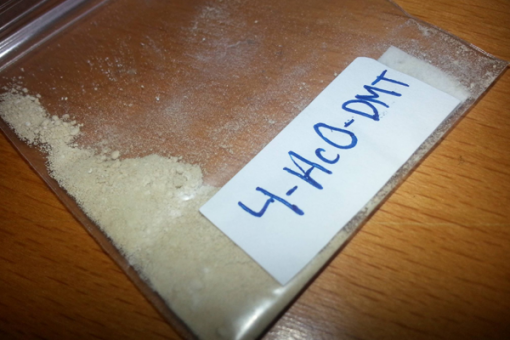4-AcO-DMT (Psilacetin) – Research Chemical for Advanced Study
4-AcO-DMT, also known as 4-Acetoxy-N,N-dimethyltryptamine or psilacetin, is a synthetic tryptamine compound that has gained significant interest in the scientific and research community for its close structural and functional similarity to psilocybin, the active ingredient in many psychedelic mushrooms. As a research chemical, 4-AcO-DMT offers scientists and qualified professionals a unique opportunity to explore the biochemical and neuropsychological mechanisms behind altered states of consciousness, serotonin receptor binding, and human perception.
What Is 4-AcO-DMT?
Psilacetin is part of the tryptamine class, a family of compounds that includes psilocybin, DMT (N,N-Dimethyltryptamine), and 5-MeO-DMT. It was first synthesized in the 1960s by the chemist Albert Hofmann—the same pioneering researcher who discovered LSD. Structurally, 4-AcO-DMT is the acetylated form of psilocin, which means it is chemically similar but features an acetoxy group at the 4-position on the indole ring. This subtle difference gives it unique pharmacological and metabolic characteristics, making it an important compound for scientific investigation.
Researchers believe that upon ingestion, 4-AcO-DMT is metabolized into psilocin, the same active compound produced by psilocybin mushrooms. Because of this, many describe it as a synthetic prodrug of psilocin, though its stability and solubility often make it more practical for controlled laboratory analysis.
Chemical Profile
-
IUPAC Name: 3-[2-(Dimethylamino)ethyl]-1H-indol-4-yl acetate
-
Chemical Formula: C₁₄H₁₈N₂O₂
-
Molecular Weight: 246.31 g/mol
-
CAS Number: 92292-84-7
-
Synonyms: Psilacetin, 4-Acetoxy-DMT
-
Form: Typically available as a fumarate or hydrochloride salt for stability
The compound is commonly supplied as an off-white or beige powder and is highly sensitive to light, moisture, and heat, which means it should be stored in airtight containers, away from direct sunlight, in a cool and dry environment.
Scientific and Research Applications
Psilacetin has attracted the attention of neuroscientists, pharmacologists, and psychopharmacology researchers due to its unique ability to interact with serotonin receptors, particularly the 5-HT2A receptor, which plays a major role in mood, cognition, and perception.
Ongoing and historical research focuses on:
-
Pharmacodynamics and receptor binding – understanding how 4-AcO-DMT and similar tryptamines interact with serotonin receptors.
-
Metabolic pathways – examining how 4-AcO-DMT converts to psilocin and its metabolites in biological systems.
-
Comparative studies – comparing its subjective and neurochemical effects with psilocybin and DMT.
-
Potential therapeutic implications – exploring how its chemical structure might inform the development of novel treatments for depression, PTSD, and anxiety under controlled conditions.
It is important to emphasize that 4-AcO-DMT is not approved for human consumption. All research involving this compound should be conducted by qualified professionals within properly equipped facilities.
Comparison: 4-AcO-DMT vs Psilocybin
While Psilacetin and psilocybin share many similarities, they differ slightly in structure and stability. Psilocybin contains a phosphate group, while 4-AcO-DMT contains an acetoxy group, which may affect absorption, onset time, and duration when metabolized.
In laboratory settings, researchers often note that 4-AcO-DMT tends to have a faster onset and may be more chemically stable than psilocybin under certain storage conditions. This makes it an appealing choice for researchers looking for a synthetic analogue that can be more easily measured, stored, and dosed.
Legal Status and Availability
The legal status of 4-AcO-DMT varies by country. In some jurisdictions, it is classified under analogue or psychoactive substance laws due to its similarity to psilocin and psilocybin. Researchers and institutions must ensure full compliance with local regulations before obtaining or studying this compound.
At Rx Anabolics (or insert vendor name), 4-AcO-DMT is offered strictly for laboratory and research purposes. It is not intended for human use, medical treatment, or recreational application. Each batch is lab-tested for purity and identity to ensure reliability and consistency for analytical studies.
Storage and Handling
To preserve chemical integrity, 4-AcO-DMT should be stored in:
-
A cool, dry place (preferably under refrigeration below 8°C)
-
Airtight, opaque containers to prevent light degradation
-
Desiccated environments to avoid moisture exposure
Proper laboratory handling procedures, including gloves, goggles, and protective equipment, are required. Always consult your institution’s safety data sheet (SDS) before handling.
Why Researchers Choose 4-AcO-DMT
-
High purity and consistency: Ideal for reproducible results in controlled studies
-
Structural similarity to psilocybin: Enables detailed comparison research
-
Synthetic stability: Easier to store and handle than naturally derived analogues
-
Versatility: Applicable in pharmacological, analytical, and behavioral neuroscience studies
Key Takeaways
-
Compound: 4-AcO-DMT (Psilacetin)
-
Category: Synthetic tryptamine, psilocin analogue
-
Purpose: Research and analytical use only
-
CAS Number: 92292-84-7
-
Form: High-purity powder (lab-tested)
-
Not for human consumption
Disclaimer
This product is sold strictly for research purposes only. It is not intended for human or veterinary use, and Rx Anabolics does not endorse or permit any misuse of the compound. All customers are required to be qualified research professionals or affiliated institutions that comply with relevant laws and ethical standards.





Green –
Good products, fast delivery and good service.
Huss –
Excellent services, highly recommended
Nuckols –
The people that work for Research chemsupplier for u are so happy to help 😀😀😀😀😀😀😀😀😀😀😀😀😀😀😀